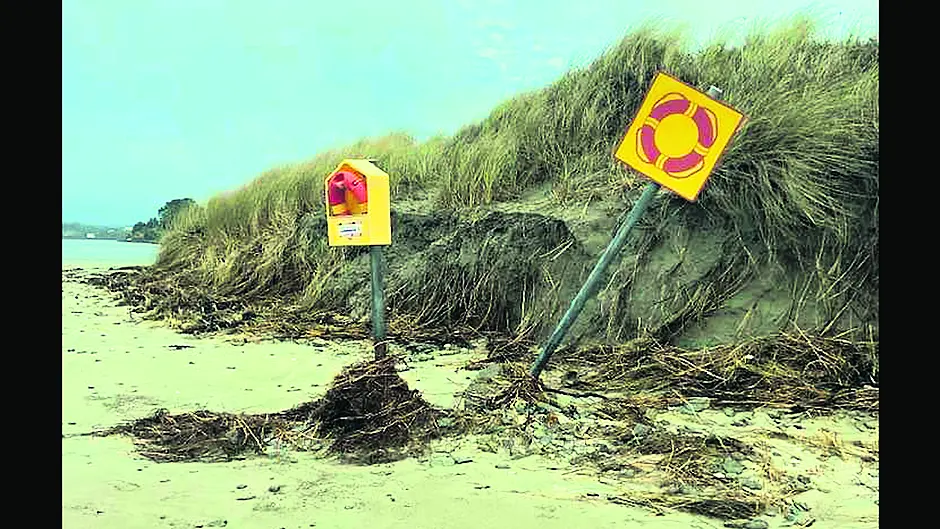Our beautiful sandy beaches are a major tourist pull. But the dunes that border them are under threat from climate change and, most especially, human footfall. Deirdre Hurley says there is a solution – if we act now
West Cork is well endowed with beautiful sandy beaches, attracting thousands of visitors every year.
Some even have Blue Flag status – a stringent environmental and safety award that guarantees a minimum standard of cleanliness and safety for users.
But the Dune systems forming the backdrop to these beaches are, unfortunately, not being afforded the same stringent environmental protection.
Our dunes are fast eroding under a persistent platoon of beach-lovers running roughshod over them, up them, and down them – either to access the beaches, or using them as an outdoor gym.
Our dunes are being eroded by people.
Sand dunes are naturally formed coastal barriers that develop behind beaches over millennia, by windblown sand accumulating around the roots of low beach-loving plants, such as sea rocket and sea couch grass, forming small hillocks of sand. Over time, the hillocks grow larger and higher until marram grass, the great dune builder, forms the high sandy hills so familiar to us all.
These insignificant looking plants have long fibrous roots that penetrate down to the base of the dune and out to its edges.
These roots keep the whole dune in place. Without marram grass, there would be no dunes.
But it’s also fragile. Incessant trampling by millions of footfalls breaks the roots, the sand blows away and the dune erodes.
Nowhere is this more obvious than on the western dunes at Inchydoney where the former high sandy hills behind the beach have been almost flattened by trampling.
Now they are being eroded and undercut from the front too, by the high seas battering the coastline with increasing ferocity and frequency.
Sea levels are also rising, and will continue to do so.
Dune erosion is a worldwide problem. Communities everywhere are joining forces with authorities to restore and save them.
Firstly, the dunes are fenced off to prevent erosion by the public. Then wooden boardwalks are constructed across the dunes for access to the beach.
The eroded dunes are then fenced off and replanted with Marram grass.
At the beach front, gabions (baskets of broken boulders) or willow hurdles, can be placed on the front of the eroded dune face, to protect it from the impact of the waves. They can be removed when the dunes recover.
Sand accumulation is achieved by placing wooden slatted barriers to trap windbown sand to reform an embryo dune in which marram will take root.
Alternatively, a buffer zone can be planted in front of the dune dissipating the force of the waves before they hit the dunes.
Dunes are an also an ecosystem rich in wildlife, stretching away beyond the sand hills on the beach, across the yellow dunes, grey dunes, down to the low-lying wetter dune slack, and up to the fixed dunes where they merge with the land.
They contain a mosaic of wildlife habitats for the hundreds of different dune plants which attract hundreds of different insects, including butterflies, bees, moths, and beetles, frogs, the Natterjack toad (Ireland’s only species of toad) in the wet areas of dune slack, and sand lizards, (Ireland’s only reptile), rabbits, hares, badgers and foxes on the fixed dunes.
Many of the thousands of migrating birds that feed on the mudflats in Clonakilty bay find nesting sites on the dunes. Biodiversity abounds.
David Attenborough, in his recent series Biodiversity, made a worldwide appeal to stop the extinction of plant and animals – to stop destroying wildlife habitats.
Ireland, as a committed member of the EU ,has signed up to the Natura 2000, pledging to protect and enhance its wildlife heritage. But it is abjectly failing to do so.
One third of Irish bees are on the verge of extinction; two thirds of Ireland’s wild birds have been listed for concern; there’s been a 40% decline in waterbirds and a shocking 85% of protected wildlife habitats including, native woodlands, sand dunes, bogs, uplands and marine habitats have a poor conservation status. Ireland’s biodiversity is in decline.
A concerned group of Inchydoney residents called the Inchydoney Dune Conservation Project is appealing to the owners and managers of the dunes to join forces with them to implement a dune restoration plan as a matter of great urgency.
Time is running out. The dune owner, Cork County Council, and the government department tasked with protecting Ireland’s wildlife, the National Parks & Wildlife Service (NPWS) all have a civic obligation to engage with a very willing local community to solve this problem, before things get any worse and the dunes are washed away.
Saving our dunes means saving Ireland’s wildlife.
• Clonakilty native Deirdre Hurley is a marine biologist and ecologist, based in London
Inchydoney in need of urgent action
BY JACKIE KEOGH
A COMMITTEE seeking the preservation of the sand dunes at Inchydoney is to write to Cork County Council to plead for action.
Cllr Paul Hayes (Ind) has raised the issue at consecutive meetings of the Council’s Western Committee.
Both he and Fianna Fáil TD Christopher O’Sullivan – who initiated Zoom meetings for stakeholders to discuss the problem – are growing increasingly concerned because more damage was done during the stormy weather before Christmas.
Cllr Hayes said the Council had previously given an indication that it would monitor the situation and he asked for an update on that commitment.
Because the beach head at Inchydoney is a special area of conservation (SAC), and is under the jurisdiction of the National Parks and Wildlife Service, the Council would need permission to carry out work.
The divisional county manager, Clodagh Henehan, said there are two forms of dunes involved, both of which are protected.
The outer layer of dunes is moveable, especially as a result of tidal surges and storm conditions.
The second type of dune is the inner, harder layer – the part where the grass grows – but this too has come under pressure.
It is here that the Council is hoping to engage with the public and remind them that walking, camping, or barbecues can harm the structure of these dunes.
In other EU countries, walking on sand dunes is against the law because the traffic prevents the grass from taking root, and it is the root structure that keeps these dunes together. Cllr Hayes warned that the increase in the number and severity of storms in recent years have taken their toll on the beach front and that there is a demonstrable difference in the appearance of the beach.
Recent photographs taken by a resident, Dena O’Donovan, show how life buoys and signs do not remain standing for long.
On a few occasions they were reinstated but stormy weather, and shifting sands, caused them to topple yet again.
Cllr Hayes requested that they be moved closer to the approved path for the public at Inchydoney.
‘It’s very worrying the amount of beach that has been lost this year,’ he added, ‘it’s time to inject some urgency into what needs to be done.’







